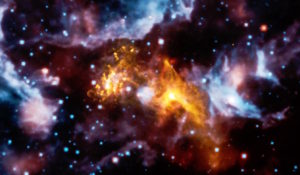
Vindicated: The once-ridiculed Prof. Piran, from the Hebrew University of Jerusalem, said he was treated with ‘utter contempt’ after publishing his heavy-metals effect prediction of a Neutron star collision, back in 1989.
By i24NEWS
For the first time, scientists have witnessed the cataclysmic crash of two ultra-dense neutron stars in a galaxy far away, and concluded that such impacts forged at least half the gold in the Universe.
But the observation is both exciting and perhaps almost bittersweet for a group of Israeli scientists who predicted the idea which was dismissed by the scientific community at the time.

Astronomers using NASA’s Chandra X-ray Observatory have discovered the largest and brightest set of rings from X-ray light echoes ever observed. These extraordinary rings, produced by an intense flare from a neutron star, providing astronomers a rare chance to determine how far it is from Earth. The rings appear as circles around Circinus X-1, a double star system in the plane of the Milky Way containing a neutron star, the dense remnant of a massive star pulverized in a supernova explosion. The neutron star is in orbit with another massive star, and is shrouded by thick clouds of interstellar gas and dust. – Photo: NASA/CXC/Univ. of Wisconsin,Madison/S. Heinz
“I am exhilarated by this confirmation of a prediction we made nearly 30 years ago,” said Hebrew University’s Professor Tsvi Piran who led a team which published an article in 1989 in the Nature scientific journal, putting forward a theory on the creation of heavy metals.
“I also remember how difficult it was to convince the scientific community of our idea — at the time it was against the standard model that was published even in freshman textbooks on astronomy,” Piran said, according to the Times of Israel.
“When we made this prediction in 1989, we did not expect it to be confirmed within our lifetimes. But with continued curiosity and the development of new technologies, we are able learn ever deeper truths about the nature of our Universe.”
Professor Piran told the Ynet news site that: “It amuses me to remember the early years after this prediction when no one wanted to listen to me and treated me with utter contempt.”
Shockwaves and light flashes from the collision traveled some 130 million light-years to be captured by Earthly detectors on August 17, excited teams revealed at press conferences held around the globe on Monday as a dozen related science papers were published in top academic journals.
“We witnessed history unfolding in front of our eyes: two neutron stars drawing closer, closer… turning faster and faster around each other, then colliding and scattering debris all over the place,” co-discoverer Benoit Mours of France’s CNRS research institute told AFP.
The groundbreaking observation solved a number of physics riddles and sent ripples of excitement through the scientific community.
Most jaw-dropping for many, the data finally revealed where much of the gold, platinum, uranium, mercury and other heavy elements in the Universe came from.
Telescopes saw evidence of newly-forged material in the fallout, the teams said — a source long suspected, now confirmed.
“It makes it quite clear that a significant fraction, maybe half, maybe more, of the heavy elements in the Universe are actually produced by this kind of collision,” said physicist Patrick Sutton, a member of the US-based Laser Interferometer Gravitational-Wave Observatory (LIGO) which contributed to the find.
Neutron stars are the condensed, burnt-out cores that remain when massive stars run out of fuel, blow up, and die.
Typically about 20 kilometers (12 miles) in diameter, but with more mass than the Sun, they are highly radioactive and ultra-dense — a handful of material from one weighs as much as Mount Everest.
View original i24NEWS publication at:
http://www.i24news.tv/en/news/technology/157896-171017-neutron-star-collision-vindicates-once-ridiculed-theory-of-israeli-scientists







 Israeli New Shekel Exchange Rate
Israeli New Shekel Exchange Rate